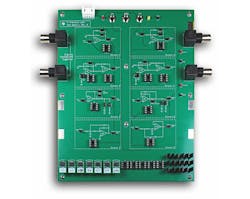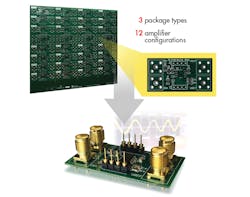Download this article in PDF format.
Whenever you need an amplifier or have a related linear-circuit design problem, most of you will turn to an op amp as a solution. Op amps are a good choice because of their universal versatility to deal with a wide range of amplification needs. And most designers at least have a working knowledge of op amps.
But how much do you really know outside of the basics taught in EE degree programs? If you said, “not much,” some additional training in op-amp technology may be a good course of action. Now you can get that necessary knowledge from several sources and products available from Texas Instruments.
Boning Up on Op-Amp Technology
Aside from standard textbook coverage as a base, perhaps the best way to educate yourself about practical design with op amps is to learn from an engineer with extensive op-amp experience. Such is the case with one of TI’s op-amp experts, Bruce Trump, and his ebook titled The Signal: A compendium of blog posts on op amp design topics.
Analog engineers typically “…acquire insights in small pieces—a bit here and a bite (not a byte) there. Slowly, puzzle pieces fit into place and hazy concepts come into focus.” That’s what amplifier expert Bruce Trump explains in his preface to The Signal, which is a compilation of 32 little op-amp lessons from his popular blog by the same name. Click here to get your free copy today.
But wait, that’s not all. While most op-amp vendors supply helpful datasheets and application notes, TI expands the learning landscape by providing resources such as its “Precision Labs.”
1. The TI-PLABS-AMP evaluation module lets you quickly and easily experiment with a wide range of op-amp types and circuits.
TI Precision Labs pairs theory and applied lab exercises to deepen the technical expertise of experienced engineers and accelerate the development of those early in their career. The TI Precision Labs—Op Amps series includes more than 40 videos spanning popular topics like Input Voltage Offset (Vos) and Input Bias Current (Ib), Input and Output Limitations, Power and Temperature, Bandwidth, Slew Rate, Noise, Low-Distortion Design, Stability, Electro Static Discharge (ESD), and Electrical Overstress (EOS).
A supplement to Precision Labs is the Op Amp Evaluation Module. Designated as the TI-PLABS-AMP-EVM, this experimenter’s board is used in conjunction with the TI Precision Labs videos to further boost your knowledge of op amps (Fig. 1).
The EVM contains eight common op-amp circuits that can be easily configured with jumpers. The module comes with multiple units of five common op-amp types that have DIP adapters to make them interchangeable. On-board jumpers allow you to quickly change interconnections. The EVM works with any standard test equipment (price is $199).
Other available support items for Precision Labs is National Instruments’ VirtualBench and the TINA-TI a circuit simulator. NI’s VirtualBench is an all-in-one virtual instrument that interfaces to a Windows laptop or iPad. It includes a mixed signal oscilloscope, an arbitrary waveform generator, a digital multimeter, three dc power supplies, and eight general-purpose I/O lines. Also in the mix is an application programming interface (API) to LabVIEW.
TINA is an analog Spice-based simulation program. This free software is ideal for analog and switched-mode power-supply (SMPS) circuit design.
Do-It-Yourself Amplifier Circuit Evaluation Module
2. The TI DIYAMP-EVM offers a convenient way for you to gain experience with op-amp circuits using three standard surface-mount technologies.
The Universal Do-It-Yourself Amplifier Circuit Evaluation Module (DIYAMP-EVM) family provides engineers and DIYers with real-world amplifier circuits, enabling you to evaluate design concepts and verify simulations in minutes (Fig. 2). The EVMs come in three industry-standard package options (SC70, SOT23, SOIC) and provide 12 popular amplifier configurations, including filters, stability compensation, and comparator circuits for both single and dual supply. They’re also available in single (DIYAMP-EVM) and dual-channel (DUAL-DIYAMP-EVM) versions (price is $20).
Learning op-amp design from one of the leading linear IC manufacturers is a worthwhile investment of your time and money. That knowledge will pay off for you time and again in future linear design projects.



